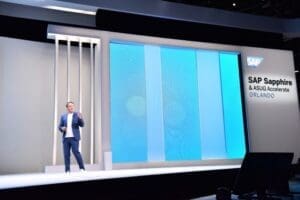
One key message emerging from Sapphire was “keep the core clean.” SAP’s user conference, Sapphire, ran from June 3rd through the 5th in Orlando. 12,000 SAP customers and partners attended the event, and another 15,000 watched remotely. SAP (NYSE: SAP) is the world’s largest provider of enterprise applications. The German software colossus has 300 million users who rely on its software.
SAP’s next-generation, feature-rich private cloud offering is known as RISE. 1,000 customers have made the transition to RISE, and 5,000 are in the process of transitioning. However, SAP has 27,000 customers. SAP’s older private cloud offering is ECC. Maintenance on ECC will end in 2027. Under some circumstances, customers can extend that to 2030. In short, SAP has thousands of customers who need to transition to SAP S4/HANA.
Historically, ERP vendors offering public cloud solutions pointed to two key advantages of multitenant offering. Implementing it can be much quicker, giving customers a quicker payback period. Customers can also continue getting new functionality without a painful upgrade process. With traditional software, the upgrade process was so painful that many companies rarely, if ever, upgraded. However, customers need to minimize customizations and extensions to get these benefits.
SAP also sells a public cloud solution called GROW. PureTech Scientific CIO Brian Hardee talked about their company’s need for a very quick implementation. PureTech is a private equity-funded carve-out from the Chemours Company’s Glycolic Acid business that happened on August 1, 2023. Glycolic acid is used in personal care products like facial peels and wipes. The new company had a minimal IT team. Mr. Hardee said SAP had great tools to support a quick implementation. They went live in a lightning-fast 15 weeks. GROW is not as functionally rich as RISE and is mainly purchased by small and medium-sized businesses. This fast of an implementation would not be possible with RISE.
Now SAP is giving its private cloud customers implementing RISE the same advice. The tagline for this is “Keep the core clean!” That message was made crystal clear at Sapphire. Historically, that has not been the case.
Tropicana Brands Group CIO Jeff Lischett also spoke from the main stage. In August of 2021, the Tropicana Brands Group was created when PepsiCo agreed to sell Tropicana, Naked, and other North American juice brands to a private equity firm. This transaction created the need to separate their IT systems from PepsiCo.
Tropicana squeezes 150 million gallons of orange juice and puts juice in 500 million bottles. With estimated revenues of over $1 billion, Tropicana is a much bigger company than PureTech, so the selection of RISE was to be expected. Nevertheless, the principle of keeping the core clean was adhered to. Ruthless prioritization and tight governance were key to being able to go live in Europe in 11 months. “This is a speed ratio we hadn’t seen” prior to RISE, Mr. Lishnet said.
SAP as part of S/4 HANA stack, also offers a feature-rich WMS known as Extended Warehouse Management (EWM). The same advice that prevails for their ERP – keep the core clean – is good advice for Cloud-based supply chain implementations.
NSK is a large manufacturer of industrial machinery bearings, precision machinery and parts, and automotive bearings and components.
NSK has committed to a five-year journey to implement RISE. They are a first-time adopter of SAP. But, the supply chain team did not want to wait five years to implement EWM. They were on a paper-based WMS solution. Ed Jabri, the vice president of supply chain at NSK, said they chose to be the “guinea pig” because they saw this as “strategic.” The use of RF devices, in combination with the data visibility EWM would improve inventory accuracy. This, in turn, would drive better customer service. Improved service was a key driver of the project.
NSK selected Stellium for their strong experience in implementing EWM. Stellium is one of SAP’s Gold status and preferred partners for supply chain execution. Within 7 months of selecting Stellium, they had gone live at their first warehouse site. After doing a fit-gap analysis, they developed a global template for the rollout that allowed for small nation-specific adjustments. Based on this methodology, they were able to implement EWM at three more sites by the end of the year.
Within 7 months of selecting Stellium, they had gone live at their first warehouse site. After doing a fit-gap analysis, they developed a global template for the rollout that allowed for small nation-specific adjustments. Based on this methodology, they were able to implement EWM at three more sites across 3 countries by the end of the year. Business operations and system confidence built through this deployment has led NSK Americas supply chain leadership to extend this capability additional warehouses in their US supply chain network and Brazil.
NSK is on track to get payback within 3 years. However, the payback calculation does not include the increases in sales they are getting due to better inventory visibility. One market they serve is the automotive aftermarket. Customers in this market want an immediate answer about whether an item is in stock and can be shipped promptly. If that answer is not quickly forthcoming, the sale very often goes to another supplier who can give a quick answer. Before EWM, it took considerable time to answer these questions. Now they can provide a promise date within a few minutes.



















